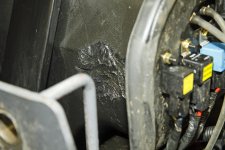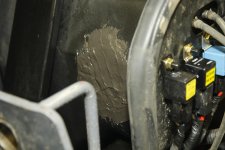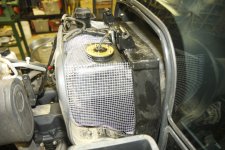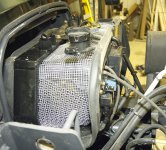I have a DK45 2008 model (I think) which I purchased new in 2010. I do not know how similar our tractors are, but I will tell you my saga anyway! (I think they are very similar)
I have had the same problem TWICE (about every 4 years). Both times the tank developed a (very) small split. Both times it was in the (nearly) exact same place, about 2 inches inboard of the fuel 'outlet' nipple, in the 'curve' that transitions from the bottom of the tank, to the 'front wall'. It is in a place that has nothing rubbing against it, or to put stress on it, the 'plastic' is VERY thick in that area, as well as many other areas (up to 1/2" thick)
The first time happened just a couple of months after the warranty expired. The parts manager volunteered to try for warranty coverage; I didn't really push it, but he said Kioti just might cover it. They didn't! To the tune of over $500 they didn't!!!
The tank is made from a plastic (HDPE, I think) that can be welded, and I was very tempted to try welding it, or find an expert to weld it, BUT (you will find) it is VERY hard to remove and replace, I have never welded plastic, and I could not find a local "expert" (that I trusted). So I decided just to go for the new tank and be done with it!! Do it once and be done, I said. I was absolutely LIVID when the new tank began leaking after very nearly the exact same time in service, then found to be leaking in the same spot!
I know everyone who has read this far is thinking there is something binding the tank, putting stress at that point. That is what I thought. I studied the tank and installation long and hard, but could not come up with a reason to explain why both tanks stared leaking in the same spot, in the same 'time in service'.
I did decide that there was no way in **** I was going to be doing this job every 4 years, and paying Kioti ransom for their shoddy tanks. I got some .050" 4130 sheet and welded up a tank made of steel! That has been a couple of years, so I guess the jury is still out whether it will last any longer; but at least I am confident that I can weld up any 'splits'.
This is quite a difficult tank to replicate; a LOT of bends, and odd shapes! The tank BARELY squeezes in and out of the tractor, so I was VERY conscious to not allow any of the dimensions to exceed the original; most were slightly smaller, but when I got through, the new tank actually holds a bit more fuel than the original.
Finally,,,, my 'second' tank started leaking at the beginning of 'hay season', and I (rightly) decided this was going to be an 'over winter' project. To get me through summer, I bolted a small piece of plywood to the right step (my tractor has a cab), then used a small ratchet strap to hold a 5 gallon gas can to the plywood 'platform'. I then drilled a hole in the 'back' of the handle that was a tight fit for a length of fuel line to be pulled through (where the vent used to be). That fuel line will need a "Tee" fitting installed so that the fuel return line can be plumbed in, then the line ran to the fuel pump inlet. The fuel filler of the can has a long flexible spout with a small 'cap' on the end. I drilled a very small 'vent' hole in that small cap. This arrangement worked remarkably well all summer! 5 gallons is plenty for my tractor to work hard all day; just needing to refuel when I came in for lunch. The (plastic) can is translucent enough so that it was easy to see how much fuel was left.
If my experience is any indication, the leak will only get worse, it is likely at the bottom of the tank, and it will continue leaking 24 hrs a day, until the fuel level drops below the split (did I mention the split is probably at the BOTTOM of the tank?)
Good luck; I do hope you have a better outcome than myself!



